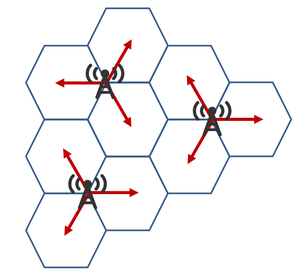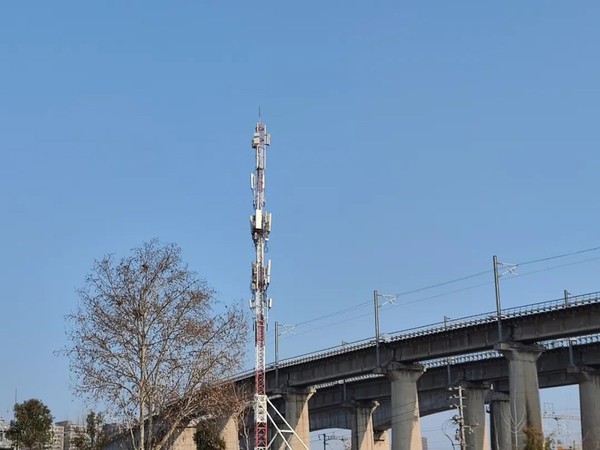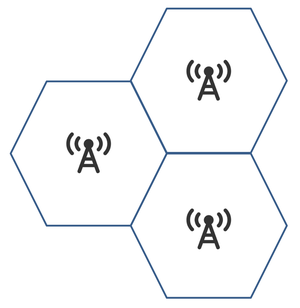What is the difference between cell, sector, carrier and RF channel?
Admin note: this post was updated with image below.

What is the difference between cell, sector, carrier and RF channel?
Admin note: this post was updated with image below.

Cell, sector, carrier, and carrier frequency are all concepts related to mobile communication base stations.
Let’s start with the base station.
The base station is an important part of the wireless access network in the mobile communication network.
The main functions of the base station are signal modulation and demodulation, radio frequency transmission and reception.
In the 4G era, the main hardware components of the base station are BBU (baseband processing unit), RRU (radio remote unit) and antenna feeder (antenna, feeder) system. In the 5G era, the hardware has changed, and the passive antenna has become an active antenna, which is AAU (Active Antenna Unit).
In real life, we often see base stations. For example as follows:

In fact, strictly speaking, the picture above is an iron tower of a physical site (or site, “station”). Hanging on the iron tower are many antennas of the base station.
Usually, a site has not only one base station, but multiple base stations.
For example, operators such as China Mobile, China Telecom, and China Unicom all have their own base stations, which are all installed on the same site.
Moreover, even if it is an operator, there are likely to be base stations of different network standards such as 2G, 3G, 4G, 5G, etc., all at this site.
When introducing antennas before, it was mentioned that antennas include omnidirectional antennas and directional antennas.
For some areas with a wide field of view and low user density, omnidirectional antennas are used to cover a large area around the area with low-frequency signals (longer wavelength, better diffraction ability, and long coverage distance). This is called “central incentive”.

For complex areas and areas with high user density, directional antennas can be used to improve signal coverage.
After calculation, the experts found that the method of 3 antennas (each covering 120°) is the most cost-effective and the best effect. Therefore, there is a design of three coverage areas for one base station.
As can be seen from the figure below, the base station is located on the three vertices of the hexagon in each cell, and each base station uses three directional antennas to cover one-third of the three adjacent cells.

The above method is called “vertex incentive” method.
You can see that the coverage of directional antennas is more flexible, which can effectively eliminate the impact of obstacles in the cell.
Of course, in addition to 3 antennas, other coverage methods can also be used, for example, 6 antennas, each covering 60°.
Whether it is 60° or 30°, the coverage area looks like a fan. This wireless coverage area is a sector (Sector). Like a base station, a sector is a physical concept and actually exists.
In the industry, there are generally names of S-type and O-type base stations. S refers to Sectorized, directional, sectoral site. O means Omni-directional, omnidirectional.
So, what is a neighborhood? Is a base station a cell? Or is a sector a community?
The answer is: not necessarily.
Before introducing the cell, I need to introduce two concepts - carrier and carrier frequency.
Carrier, the English name carrier, is also a physical concept. Generally speaking, it refers to the modulated wireless electromagnetic waves that carry information such as audio and video. Each carrier will occupy a certain range of frequencies.
The carrier frequency is the carrier frequency. There are many references to the carrier frequency, sometimes it refers to the frequency value, and sometimes it refers to the related hardware. The value of the center frequency of the carrier is the center frequency point.
If there is only one carrier in one sector, the capacity may not be enough. At this time, multiple carriers will be configured.
A sector is a physical concept, while a cell is a logical concept. Different network standards have different definitions of cells.
In 2G GSM, cell = sector.
2G GSM is a narrowband system with a small single carrier capacity. Therefore, multiple carriers are “bundled” together to form a “cell”.
For example, S 2/2/2 means: the site has 3 cells (sectors), and each cell has 2 carriers.
In 3G WCDMA, 4G LTE, and 5G, cell = carrier.
3G WCDMA is broadband CDMA, and 4G LTE has a larger single-carrier bandwidth. For one sector, it is enough to configure 1-2 carriers.
If it is S 1/1/1 configuration, 3 sectors, and each sector has only 1 carrier, then there are 3 cells in total. (Scrambling codes are used to distinguish between cells, for example, 1, 2, and 3 are used for scrambling codes).
If it is S 2/2/2 configuration, 3 sectors, each sector has 2 carriers, then there are 3×2=6 cells in total. (The number of cells that can be configured in a single sector is related to hardware capabilities.)
We can also memorize it in this simple way—the bandwidth is small, the number of carriers is large, and multiple carriers are configured as one cell. If the bandwidth is large, the number of carriers is small, and one carrier is one cell.
In conclusion:
A wireless coverage area identified by a base station identity code (Base Station Identity Code, BSIC) or a global cell identity code (Cell Global Identifier, CGI) is called a cell.
A cell is the smallest service area unit that provides terminal access. It is virtual and logical. The system defines it, and then engineers can treat it as an object for parameter configuration and management control.
The key to distinguishing a community is whether it can provide independent services.
GSM has multiple carriers in one cell, but only one broadcasts BCCH (broadcast control channel). Therefore, a cell can provide cell services only when multiple carriers are combined.
Different carriers of WCDMA and LTE have pilot signals, which are independent.
Therefore, a carrier is a concept of a cell.
Source: What Is The Difference Between A Cell And A Sector, Carrier Frequency And Carrier? - Knowledge
Thanks a lot for your insightful feedback.
Could you please tell what is the difference between cell and RF channel?